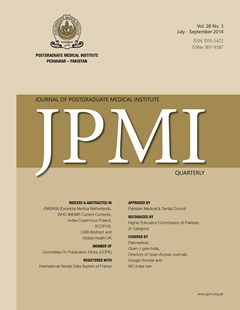Ergonomic education – A tool to maintain health
Main Article Content
Abstract
Objective: To identify the occurrence of leg pain amongst computer users and assess its relation to age, sex, occupation and duration of computer use.
Methodology: It was a cross sectional study conducted from January till December 2011. A self reported questionnaire tailored with Occupational Health and Safety Act of the Ministry of Labor, Ontario, Canada was used. Participants were randomly selected; responses analyzed by SPSS software version 15. Chi square test was applied to results and considered significant with p value <0.05
Results: A total of 416 participants responded with mean age of 34.87±8.78 years. There were 231(55.5 %) males. Out of 416, 123(29.5%) participants had work related leg symptoms [66(15.8%) male and 57 (13.7%) female]. Occurrence of leg pain within one to two hours of consecutive work was significantly more in 26-35 and 36-45 year age groups. Postural changes incorporated through frequent short breaks improved leg symptoms in between eight to nine out of ten participants (104/123). The improvement was significantly more in 26-35 and 36-45 year age groups. Leg symptoms showed no relation with the length of computer usage or daily usage or between both sex and working groups.
Conclusion: Leg pain/tingling/numbness is an early sign of repetitive injuries that can be timely addressed by ergonomic education and improving postural health through short breaks.
Article Details
Work published in JPMI is licensed under a
Creative Commons Attribution-NonCommercial 2.0 Generic License.
Authors are permitted and encouraged to post their work online (e.g., in institutional repositories or on their website) prior to and during the submission process, as it can lead to productive exchanges, as well as earlier and greater citation of published work.


